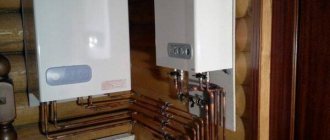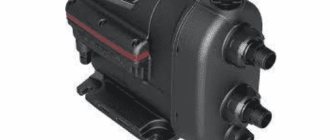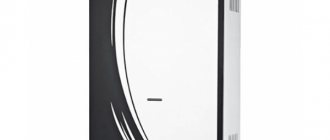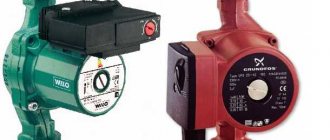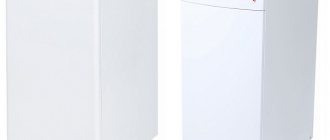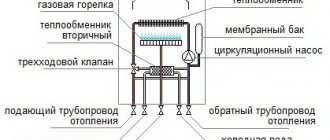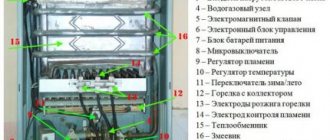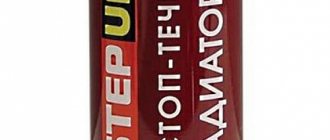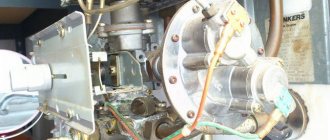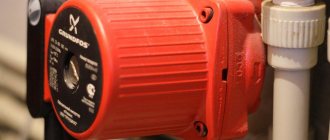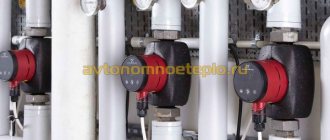Main types of breakdowns of Grundfos pumps
If you know how to handle equipment and have an understanding of the technical structure of water pressure equipment, you can repair the pump yourself.
To do this, you will need to correctly determine the cause of the breakdown and choose a method to eliminate it. Pumping equipment almost always breaks down suddenly, without any special warning signs.
All pumps, regardless of their technical characteristics or operating principle, are most often susceptible to the following malfunctions:
- There is no torque on the moving parts of the equipment.
- Spontaneous shutdown of the device.
- High levels of noise or vibration.
- Low water pressure.
If the device hums, but does not spin, then there is a high probability of oxidation of the rotating shaft, or calcification of the rotating parts. This is possible as a result of long-term downtime of internal mechanisms. When the device not only does not spin, but also does not hum, most likely the problem is in the power supply to the motor. Spontaneous shutdown of pumping equipment indicates the presence of mineral deposits between the starter and rotor.
Loud noise during operation is usually caused by air leaks into the water supply pipes due to depressurization of the unit. Vibration indicates faulty bearings on the rotating components of the pump. A drop in pressure is usually caused by clogged filters, or by improper connection of the device to a three-phase power source.
Dry and wet type of device
Such pumps are divided into the following types: with a “dry” and “wet” rotor. In the first case, the motor of the pumping device is placed in a separate module, and the rotor rotates through a clutch.
Noise occurs during operation.
Why is the heating pump humming?
Dry type equipment creates noise through the operation of a fan that cools the engine. This device is used in large houses. In them it is mounted in a separate room.
Wet-type devices operate with low noise levels, since the rotor is immersed in a coolant that cools the operating engine. Such a device can be placed close to residential premises. The noise level will not create any discomfort.
Other causes of humming
If the noise does not arise from the operation of the fan, then why is the circular heating pump humming?
The reasons may be the following:
- installation was carried out with violations;
- cavitation loads, to avoid this, you need to install a hydraulic compensator, which allows you to control the pressure in the system;
- due to the presence of air in the system: this problem usually occurs when heating is started at the beginning of the season. This cause is characterized by a sharp noise. It is necessary to remove such air pockets for the full functioning of both the pump and the entire heating system;
- incorrectly selected circular pump: noise usually occurs if a device with a higher power is selected than required by the technical specifications for heating the house;
- mechanical failure of the device; to eliminate the cause, it is necessary to remove and disassemble the device;
- presence of gaps, runout of the motor shaft - replacement of the adjusting washers is required.
In fact, the hum of a device can be caused by design features, that is, it is natural noise during operation, or a hum of a different nature that occurs during operation.
Problems with the circulation pump may occur as a result of its heating.
Reasons for pump heating
Heating can occur during engine operation; usually, cooling is provided for this either by a coolant or a fan. Excessive heating is possible from stopping the rotation of the rotor. In case of any breakdowns, it is necessary to disassemble the device; if it is impossible to fix the problem yourself, contact a specialist.
Circular pump for a heating system - why is it needed, how does it work
Calculation of a circulation pump for heating: formula, nuances
Inverter for a heating pump - do we do it ourselves or buy a ready-made one?
A circulation pump is a common element of an individual heating system in one’s own home. This device makes it possible to efficiently circulate the coolant through a closed circuit, thereby ensuring a constant temperature in all areas of the heating system and the complete absence of air pockets there. But even with the most reliable equipment, sometimes troubles occur in the form of malfunctions. Therefore, sometimes it is necessary to repair the circulation pump in order to return the home heating system to its original efficiency.
It is noteworthy that, despite the diversity of the model range of circulation pumps, the principles of their operation and maintenance are the same for all devices. Therefore, in this material we will consider options in which you can avoid the services of professional specialists at a service center and repair the circulation pump yourself.
In order to understand the principle of repairing pumping equipment, it is necessary to thoroughly understand its structure. Such knowledge will help to identify faults in the mechanism and eliminate them many times faster.
So, the design of a standard circulation pump for heating systems looks like this:
- A large horizontally elongated steel case in which all the working components of the system are located. In addition to steel, durable aluminum alloy or stainless steel can be used for the unit body.
- The housing houses a powerful electric motor and rotor.
- Here, an impeller with blades that are curved in the opposite direction from the movement of the wheel is fixed on the rotor. As a rule, this pump element is made from durable polymers.
How to disassemble Grundfos
When you are absolutely sure that the cause of the problem is some internal problem in the mechanism, you should begin disassembling the pump.
Before this, it should be disconnected from the power supply and the water should be drained from the internal cavities and tubes. You should start disassembling the device from the junction box, after which a visual inspection of the internal components is carried out. In this way, you can find a burnt or failed part. In a situation where all the components in this part of the device are in working order, you should continue disassembling.
Grundfos deep-well pumps are disassembled as follows:
- The body is firmly clamped in a vice. This is best done using two halves of a steel pipe of the appropriate diameter. This eliminates the possibility of deformation of the device body.
- If you cannot unscrew the lid by hand, the threaded seam should be lubricated with a special liquid. Often, silt and dirt accumulate at the junction of the cover and the body itself, making it difficult to turn the thread.
- After removing the cover, remove the rotor from the working chamber.
When disassembling, the pump motor must be in a vertical position. In this case, the leakage of lubricating oil from it can be avoided.
Frequent causes of Sololift2 failure
As noted above, most breakdowns are associated with improper operation of the equipment. The most common reasons include:
Connecting to a dishwasher or washing machine a pump that is not intended for forced transportation of high-temperature liquids. Working in overheating mode, Sololift fails. In such a situation, replacing the electric drive will not solve the problem - it is necessary to change the pump itself to model C-3, which is designed for pumping hot liquids. Entry of foreign objects (ropes, rags, plastic, personal hygiene products, etc.) into the cutting mechanism. Leads to pump jamming and motor overheating. As a result, after some time of such work, one of the windings burns out. The problem is solved by replacing the electric motor. Flushing various construction mixtures and adhesives into the toilet during repairs leads to their sticking to the moving parts of the pump. This can lead to slower operation of the unit (even to a complete stop) and overheating of the electric motor. The engine burns out, and replacing it will cost the owner almost half the price of a new Sololift. Leaving the pump in an unheated room (in a country house or country house) during the winter. The ice that forms inside deforms the Sololift from the inside. The breakdown also does not apply to the warranty case - the fault can only be eliminated by replacing the pump part at your own expense. Liquid getting into the electrical part of the Sololift. Moisture can cause burnout and complete failure of electrical devices. Lack of preventive measures for timely diagnosis and cleaning of sewer pipes from various contaminants, as a result of which the equipment fails. Partial blockage of the outlet pipe leads to frequent starts and overheating of the engine, as a result of which it can also fail
To minimize the likelihood of such a situation occurring, it is important to provide at the stage of piping so that there are as few bends as possible. When laying, you should also maintain the required slope, and it is advisable to choose pipes with a larger diameter. Untimely cleaning of the Sololift drain chamber components
If the pump has not been disassembled or washed for many years, there is a high probability that due to all kinds of deposits and accumulation of dirt, the level sensor and pressure switch are not working correctly. For these reasons, the pump can either turn on every once in a while or very often.
Thanks to the ease of maintenance and simple design, even a beginner can diagnose and repair Sololift2 series pumps with his own hands
However, it is important to strictly follow basic safety rules. First of all, you need to turn off the power to the unit and make sure that all rotating components are stopped
Grundfos repair
To diagnose the engine, you will need an ohmmeter.
When you rotate the handle of this device, it produces a voltage of about 200V. If the ohmmeter readings are extremely high, tending to plus infinity, then there is a break in the working phase. If the resistance values are very small, then we can confidently talk about a short circuit between the turns of the electric motor. It is impossible to carry out high-quality engine repairs with such problems at home, and it should be taken to a specialized workshop.
If everything is in order with the engine and electrical equipment, the cause of the malfunction may be mechanical breakdowns, or clogging of the internal working spaces with debris, silt, or mineral deposits. In this situation, the insides of the pump are washed in running water and thoroughly cleaned with a brush. Particular attention should be paid to bearings, water supply wheel, and valves. O-rings and seals must be in good condition, elastic and without mechanical damage.
After cleaning the parts and components, you can reassemble the device and try to start it up again. At the same time, do not forget to fill the working chambers of the device with water. Running it “dry” will certainly lead to an even more serious breakdown, after which it will be necessary to repair the pumping station at a service center.
Causes and troubleshooting
- the pump turns on, but the rotor does not work. If the main element of the circulation equipment refuses to rotate, then the most obvious reason is a problem with the power supply. For example, if power surges frequently occur in the network, the fuse in the pump begins to melt, thereby breaking the electrical circuit. The solution to the problem in this case consists of two steps. First, get your network working. Secondly, replace the fuse with a new one. If everything is fine with it initially, then carefully inspect the remaining elements responsible for receiving power to the device. If damage is found to the wire or switch, they should also be replaced. It is strictly forbidden to use them if they are broken, as this can lead to complete breakdown of the equipment and harm to the health of the owners. Another point that should be checked is the condition of the electric motor winding. What is important here is the resistance indicator, which is measured using a multimeter. For some rotor models it should be from 10 to 15 ohms, for others - from 35 to 40 ohms. This depends on the specific equipment. The resistance inherent in a normally operating winding is usually indicated in the technical documentation supplied with the device. If, when tested, the multimeter displays infinity or something near zero, then this means that the winding is faulty and this element will have to be replaced;
- the pump overheats. Normally, the temperatures of this device and the pipe should match. If you find that the pump is significantly hotter than necessary, there could be several reasons for this. The first of them is incorrect installation. In this case, you will observe overheating as soon as you install the new pump. The only way to fix this is to disassemble everything again and reassemble it the way it should be. The second reason may be that the device is clogged. Most often, this is typical for heating systems that use elements susceptible to corrosive processes - for example, low-quality steel pipes. Particles of rust that form on the inner walls sometimes fall off, and the coolant carries them wherever it goes - including to the circulation pump. If the latter becomes clogged, then it has to apply more effort to ensure normal fluid flow, hence overheating occurs. The problem is solved by cleaning the filter installed inside the device, as well as all elements of the equipment where dirt has clogged. The third possible cause of overheating is insufficient or complete absence of lubricant on the bearings. This leads to a deterioration in their performance and abrasion of the elements. The solution to the problem is obvious - you need to lubricate the parts again. And the fourth reason for overheating, which is worth mentioning, is too low voltage in the electrical network. In order for the pump to work normally, it needs 220 V. If you find that the voltage in your network is less, then it is useless to deal with the circulation equipment - adjust the power supply;
- The coolant circulates with insufficient pressure. This also indicates some kind of malfunction in the operation of the equipment. As with overheating, clogging of structural elements can play an important role here. The fix method is still the same - cleaning. Also, if your network voltage is not 220 V, but 380 V, be sure to check that the pump is connected correctly. It often happens that the electrical wire is connected to the wrong phase, hence problems with the power of the equipment.
circulation pump inspection
By the way, you can make your life much easier if you initially purchase equipment with overheating and dry-running sensors. They will monitor the state of affairs and if problems arise, immediately turn off the pump, thereby signaling you about problems. This approach will help to avoid serious repair work, because the earlier a malfunction is detected, the less damage will be caused to the equipment.
We are confident that now you can easily cope with both disassembling and repairing the circulation pump. To consolidate the information, also watch the video, the link to which is located below. Good luck!
Grundfos service
To avoid the above problems, you should follow the operating rules of pumping equipment, as well as perform timely maintenance. Installation of Grundfos deep-well equipment and trial operation are best left to professionals. Before starting pumping stations, you should always make sure that there is water in them to avoid dry starting.
If you use the pump only in the summer season, then the rest of the time it should still be turned on, at least for half an hour every 3-4 weeks. This will avoid problems with oxidation of its internal parts. With Grundfos drainage pumps, special attention should be paid to the permeability of pipes and pipes. Since such equipment operates in particularly difficult conditions, which entail the risk of clogging, it is necessary to clean it from time to time with a strong stream of water.
About the choice of equipment and the rules for its independent calculation
The key indicator that determines the efficiency of the circulation pump is its power.
For a household heating system, there is no need to try to purchase the highest-power installation. It will only make a loud noise and waste electricity. Mounted circulation pump
You need to correctly calculate the power of the unit based on the following data:
- hot water pressure indicator;
- pipe section;
- productivity and throughput of the heating boiler;
- coolant temperature.
Hot water consumption is determined simply. It is equal to the power indicator of the heating unit. If, for example, you have a 20 kW gas boiler, no more than 20 liters of water will be consumed per hour. The pressure of the circulation unit for the heating system for every 10 m of pipes is about 50 cm. The longer the pipeline, the more powerful the pump you need to purchase
Here you should immediately pay attention to the thickness of the pipe products. The resistance to water movement in the system will be stronger if you install pipes with a small cross-section. In pipelines with a diameter of half an inch, the coolant flow rate is 5.7 liters per minute at the generally accepted (1.5 m/s) speed of water movement, with a diameter of 1 inch - 30 liters
But for pipes with a cross-section of 2 inches, the flow rate will already be at the level of 170 liters. Always select the diameter of the pipes so that you do not have to overpay extra money for energy resources
In pipelines with a diameter of half an inch, the coolant flow rate is 5.7 liters per minute at the generally accepted (1.5 m/s) speed of water movement, with a diameter of 1 inch - 30 liters. But for pipes with a cross-section of 2 inches, the flow rate will already be at the level of 170 liters. Always select the diameter of the pipes in such a way that you do not have to overpay extra money for energy resources.
The flow rate of the pump itself is determined by the following ratio: N/t2-t1. In this formula, t1 refers to the temperature of the water in the return pipes (usually it is 65–70 °C), and t2 is the temperature provided by the heating unit (at least 90 °C). And the letter N denotes the boiler power (this value is in the equipment passport). The pump pressure is set according to the standards accepted in our country and Europe. It is believed that 1 kW of power of a circulation unit is quite enough for high-quality heating of 1 square meter of a private home.
Should it be warmed up?
The main reason for installing this type of pump is the forced acceleration or deceleration of fluid flow through pipelines under pressure. Due to the conversion of electrical energy into kinetic energy, and due to the friction of the pump components among themselves during operation, its heating should be observed. However, temperatures increase slightly. The pump accelerates hot water, which also contributes to heating. Therefore, the heat generated by the pipe should be approximately the same.
It is much worse if the pump is much hotter than the pipeline. This indicates a malfunction.
How to prepare circulation pumps for the winter heating season
In order for your heating pump to operate smoothly throughout the cold season, routine maintenance must be carried out before the start of the heating season.
- Check that the pump is connected correctly to the heating piping network. Pumping equipment must be installed in a place in the irrigation network where there is minimal possibility of air pockets forming. It is rational to place it on the return line, in front of the heating boiler.
- Before starting operation, make sure that all connecting elements of the network have maintained their tightness. To prevent the gasket from drying out, the inlet and outlet pipes are coated with a preservative lubricant during breaks in operation.
- Check the condition of the filter in front of the pump inlet. Replace or clean it if necessary.
- Check that the device is properly connected to the power supply. Not only the density of the contacts on the terminal box and the serviceability of the fuse are checked, but also the correct connection of the phases and the operating voltage in the network. The best way to check these characteristics is with a tester.
- Before starting to operate the heating circulation pump, be sure to carry out a test run, which should confirm the complete tightness of the system and the serviceability of all its components and equipment.
Principle of operation
To organize the operation of a regular home water supply, pumping stations (PS) with a hydraulic accumulator are used. Starting and stopping the pump in such systems is carried out using a pressure switch. This device, configured to a certain pressure range in the pipe, closes the contact group at its minimum value and opens at its maximum.
To prevent the pump from turning on every time one of the residents opens the tap (frequent starts shorten the service life of the engine), a hydraulic accumulator is connected to the water supply. From the name it is clear that this tank is needed to create a supply of water, but it accumulates not only it.
Hydraulic accumulator
This part of the NS also has characteristic “diseases”:
- depressurization of the housing;
- rupture of the cylinder or membrane (in this case, when you press the spool, water will flow from the tank);
- decrease in air pressure for natural reasons.
In all cases, the same symptom will be observed: the pump turns on every time the tap is opened.
The pump gets very hot even when the boiler is cold
Excessive heating of the pump using cold coolant indicates that it is operating at increased load. Therefore, you should disassemble it yourself and check everything or send it to a diagnostic center, where this work will be performed by qualified craftsmen.
